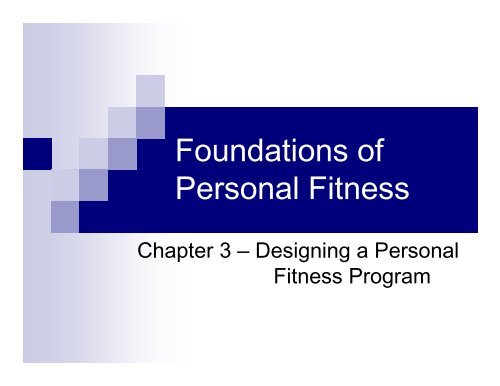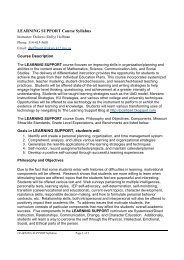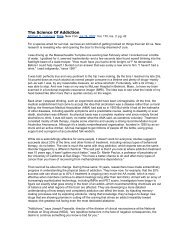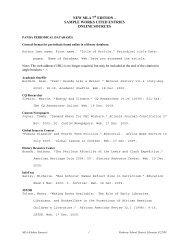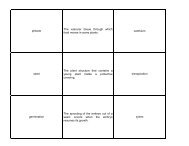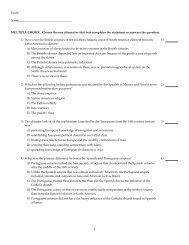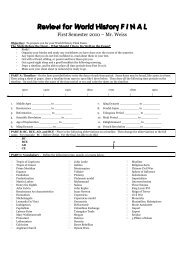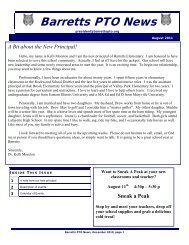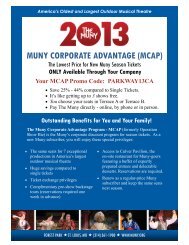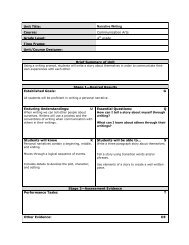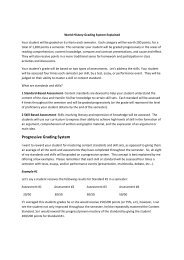Foundations of Personal Fitness
Foundations of Personal Fitness
Foundations of Personal Fitness
You also want an ePaper? Increase the reach of your titles
YUMPU automatically turns print PDFs into web optimized ePapers that Google loves.
<strong>Foundations</strong> <strong>of</strong><br />
<strong>Personal</strong> <strong>Fitness</strong><br />
Chapter 3 – Designing a <strong>Personal</strong><br />
<strong>Fitness</strong> Program
Lesson 1 - Health-Related<br />
& Skill-Related <strong>Fitness</strong><br />
Health-Related <strong>Fitness</strong>: This is your ability to<br />
become and stay physically healthy.<br />
Skill-Related <strong>Fitness</strong>: This is your ability to<br />
maintain high levels <strong>of</strong> performance on the<br />
playing field.<br />
While your level <strong>of</strong> skill-related fitness is reflected<br />
in how well you perform a physical activity, you<br />
level <strong>of</strong> health-related fitness provides a<br />
measure <strong>of</strong> your physical health. Improving in<br />
one area may lead to improvements in others.
Health Related<br />
Components <strong>of</strong> <strong>Fitness</strong>
Skill Related<br />
Components <strong>of</strong> <strong>Fitness</strong>
3 Principles <strong>of</strong> Training<br />
Overload<br />
Progression<br />
Specificity
Lesson 2 - The Overload Principle<br />
In order to improve your level <strong>of</strong> fitness,<br />
you must increase the amount <strong>of</strong> regular<br />
activity or exercise that you normally do.
FITT Formula<br />
Frequency = How <strong>of</strong>ten<br />
you exercise
FITT Formula<br />
Intensity = How hard<br />
you are exercising
FITT Formula<br />
Time = How long you are<br />
exercising
FITT Formula<br />
Type describes what<br />
exercise you are doing
Lesson 4 - Principle <strong>of</strong> Progression<br />
As your fitness levels increase, so do the<br />
factors in you FITT.<br />
Progression involves gradually increasing<br />
the intensity & time <strong>of</strong> activity to continue<br />
achieving overload
Progression Principle
Lesson 3 - The Principle <strong>of</strong><br />
Specificity<br />
Overloading a particular component will lead to<br />
fitness improvements in that component alone.<br />
Specificity means that<br />
you must do ‘specific’<br />
exercises to improve<br />
each <strong>of</strong> the 5 health related<br />
components <strong>of</strong> fitness.
Lesson 5 –<br />
Warm Up, Work Out, Cool Down<br />
Component<br />
Warm-up<br />
Type <strong>of</strong> Activity<br />
Cardiovascular, stretch, low-level<br />
calisthenics, walking<br />
Time<br />
(minutes)<br />
10<br />
Workout<br />
Cardiovascular Conditioning:<br />
walk, jog/run, swim, bike, crosscountry<br />
ski, dance, stair step, in-line<br />
skating<br />
Muscular Conditioning:<br />
calisthenics, weight training<br />
20-50<br />
15-30<br />
Cool down<br />
Walking, stretching<br />
5-10
Warm Up<br />
The warm-up is a portion <strong>of</strong> a complete workout<br />
that consists <strong>of</strong> a variety <strong>of</strong> low-intensity<br />
activities that prepare the body for physical work.<br />
Primary purpose: to raise your heart rate<br />
gradually before physical activity or exercise.<br />
Which in turn will raise your muscle temperature<br />
and allow your muscles to work safely and more<br />
efficiently.
Active vs. Passive Warm Up<br />
An ACTIVE warm up raises body temperature by<br />
actively working the body systems centering on<br />
the muscles, skeleton, heart and lungs.<br />
An active warm up will have two phases:<br />
Cardiovascular phase – gradually increases the<br />
heart rate and body temperature (i.e., jogging slowly,<br />
stationary cycling at low resistance, etc.)<br />
Muscular-skeletal phase – designed to loosen up<br />
the muscles and connective tissues (i.e., static<br />
stretches)
Check for understanding:<br />
An active warm up consists <strong>of</strong><br />
a cardiovascular phase and a<br />
muscular-skeletal phase.<br />
What phase <strong>of</strong> the warm up is<br />
this athlete performing?<br />
Answer: Muscular-skeletal Phase
Active vs. Passive Warm Up<br />
In contrast, a PASSIVE warm up raises the<br />
body temperature through outside heat<br />
sources.<br />
(Ex: blankets, hot baths, saunas, or skin<br />
creams)<br />
*Obviously, the active warm-up is a far more<br />
effective way <strong>of</strong> preparing your body for physical<br />
activity.
2 Types <strong>of</strong> Active Warm Ups<br />
Specific warm up vs. General warm up<br />
Specific = structured primarily for skill or gameoriented<br />
activities.<br />
Example: a specific warm up for basketball might<br />
include lay ups, jump shots and upper and lower body<br />
stretches<br />
General = less structured, usually used for individual<br />
activities.<br />
Example: a general warm up for swimming or<br />
jogging might include running in place, calisthenics,<br />
and various stretches
Warm Up Guidelines<br />
<br />
<br />
<br />
<br />
<br />
Remember to do a cardiovascular and muscular-skeletal<br />
phase in every warm up<br />
Start slowly, and gradually increase intensity<br />
Warm up for five to fifteen minutes in temperate weather.<br />
When it’s cold, increase time<br />
Design a specific warm-up intended for your exercises or<br />
physical activities<br />
Make your warm-up intensity high enough to produce an<br />
increased heart rate, increased breathing rate, and a<br />
light sweat
Workout<br />
The workout phase <strong>of</strong> your fitness<br />
program is the period <strong>of</strong> time that you<br />
should spend daily, or almost daily, in<br />
physical activity or exercise.<br />
A well designed workout phase should be<br />
based on scientific exercise principles and<br />
tailored to your personal fitness goals.
Sample <strong>Fitness</strong> Prescription for a<br />
Teen<br />
Frequency<br />
3-5 days per week<br />
Intensity<br />
Time<br />
Type<br />
Resistance-<br />
Weight Training<br />
Flexibility<br />
Moderate to vigorous &<br />
continuous if possible<br />
Accumulate 20-60 minutes<br />
on each session<br />
Walk-hike, run-jog, bike,<br />
cross-country ski, dance,<br />
skip rope, stair climb, swim,<br />
inline skate, endurance<br />
games<br />
8-10 exercises, 2-3 times<br />
per week<br />
Include warm-up and cooldown<br />
stretches
Cool down<br />
Every bit as important as the warm up!<br />
The main job <strong>of</strong> the cool down is the<br />
opposite <strong>of</strong> the warm up: it is to lower your<br />
heart rate gradually
Cool down<br />
Like the warm-up, the cool down has two<br />
phases that should occur in this order:<br />
Cardiovascular cool down: consists <strong>of</strong> moving<br />
about slowly and continuously for three to five<br />
minutes following physical activity.<br />
Stretching cool down: involves<br />
three to five minutes <strong>of</strong> stretching.
Critical Thinking:<br />
If a friend tells you that she started an exercise<br />
program to improve her physical fitness but quit<br />
after 2 weeks because she didn’t see any<br />
improvements, what would you tell her?<br />
Possible answers:<br />
She didn’t stay with it long enough, it takes longer<br />
than 2 weeks to get out <strong>of</strong> shape – so it will take<br />
longer than 2 weeks to get back in shape.<br />
She may have unrealistic expectations.<br />
She can improve her chances for success by learning<br />
more about personal fitness


